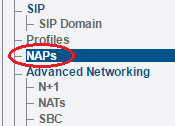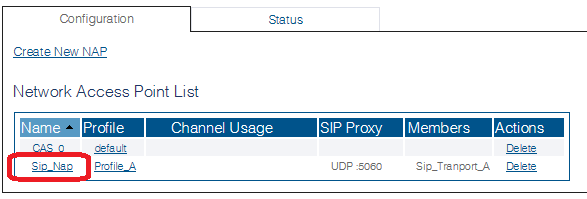Toolpack:Associate Local NAT to NAP
From TBwiki
(Difference between revisions)
(grammatical corrections for #4 and #5) |
m (needs revising edit) |
||
| Line 11: | Line 11: | ||
[[File:EnableSipISipT_1.png]]<br /><br /> | [[File:EnableSipISipT_1.png]]<br /><br /> | ||
| − | 3. Click | + | 3. Click '''Network Address Translation (NAT)''':<br /> |
[[File:Configuring_remote_or_local_nat_traversal.jpg|500px]]<br /><br /> | [[File:Configuring_remote_or_local_nat_traversal.jpg|500px]]<br /><br /> | ||
| Line 29: | Line 29: | ||
[[File:selecting_local_method_for_sip_nat_traversal.jpg|900px]]<br /><br /> | [[File:selecting_local_method_for_sip_nat_traversal.jpg|900px]]<br /><br /> | ||
| − | 6. Click | + | 6. Click '''Save'''. |
| − | + | ||
| − | + | ||
| − | + | ||
Revision as of 12:06, 1 May 2018
Applies to version(s): v3.0
We assume at this point that a SIP NAP or a SIP Open NAP has already been created and allocated.
To configure a Local Symmetric NAT Traversal
1. Select NAPs in the Navigation Panel:

2. Select an existing SIP NAP in the list:

3. Click Network Address Translation (NAT):

4. We assume that a local NAT has been created and allocated. SBC/Tmedia can be configured for RTP messages traversing a local NAT as follows:
- No NAT: SBC/Tmedia is not behind a NAT for RTP messages.
- Existing [Local NAT name] item: local NAT name that will be used for the local RTP traversal method.
Select the appropriate method for RTP NAT Traversal.
5. We assume that a local NAT has been created and allocated. SBC/Tmedia can be configured for SIP messages traversing a local NAT as follows:
- No NAT: SBC/Tmedia is not behind a NAT for SIP messages.
- Existing [Local NAT name] item: local NAT name that will be used for the local SIP traversal method.
Select the appropriate method for SIP NAT traversal.
6. Click Save.

